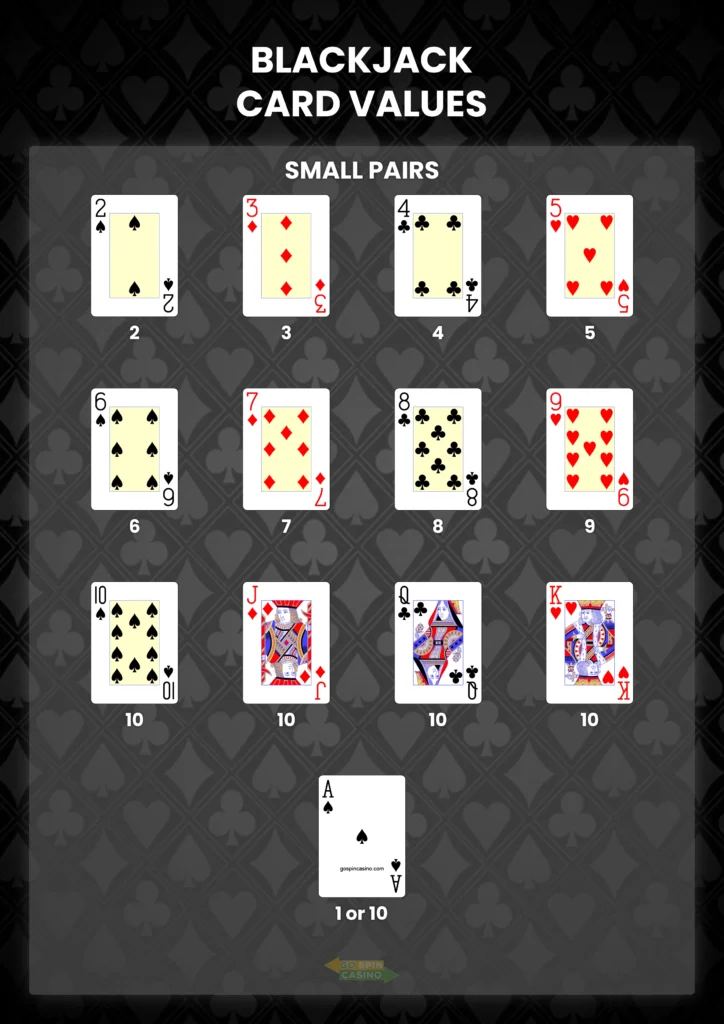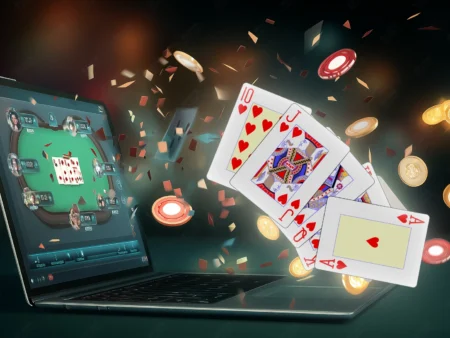You can’t beat blackjack if you’re guessing your totals. Every hit, stand, double, or split starts with one skill: reading blackjack card values fast and accurately. Miss by a point and you’re handing chips to the dealer. Nail it, and the whole game slows down in your favor.
Here’s the straight shot from years around real and virtual tables: 2–10 are worth their number, J/Q/K are always 10, and the Ace is the shape‑shifter, 1 or 11 depending on what helps your hand. You’ll get a clean blackjack value table you can screenshot, quick examples that mirror real hands, and simple drills to make the math automatic. We’ll also clarify a common confusion: understanding card values isn’t the same as “how to count cards.”
By the end, you’ll add totals in a heartbeat, spot soft vs. hard hands without thinking, and avoid rookie traps (like misplaying an Ace after a hit). That’s the baseline every confident blackjack player at Vaya Spin Casino builds on.
Tabla de contenido
- The Basics – Blackjack Card Values
- Aces – The Card That Changes Everything
- How to Add Up Your Hand (Without Overthinking It)
- “How to Count Cards” – What It Is (and Isn’t)
- Practice Examples You Can Try Right Now
- When Card Values Matter Most – Decision Points in Blackjack
- Common Mistakes Beginners Make With Card Values
- FAQ – Quick Answers for New Players
The Basics – Blackjack Card Values
En esencia, blackjack card values are simple, and they never change whether you’re playing a single deck or an eight-deck shoe. A 7 is always worth 7, a King is always worth 10, and the Ace is your wildcard, counting as either 1 or 11 depending on what gives you the stronger hand.
This consistency is one of blackjack’s biggest appeals. But don’t mistake simple for unimportant. The faster you can read your total, the more focus you can put on actual strategy, deciding when to hit, stand, double, or split without second-guessing yourself.
The Blackjack Value Table (Quick Reference)
Here’s the chart you’ll want to burn into your memory. It’s the same everywhere, from the Vegas pit to a live dealer lobby to a digital table at one of our casinos en línea recomendados.
| Card | Value | Notas |
| 2–10 | Face value | Matches the number on the card |
| J, Q, K | 10 | All face cards have equal value |
| As | 1 or 11 | Count as 11 unless it would bust your hand, then count as 1 |
Consejo profesional: Memorize this and you’ve mastered step one. Everything else in blackjack, from betting strategy to knowing when to take insurance, builds on this foundation.

Aces – The Card That Changes Everything
If there’s one card in blackjack that can swing a hand from weak to winning, it’s the Ace. Every other card has a fixed value, but the Ace plays both sides, 1 or 11, depending on what keeps your total in the sweet spot.
This flexibility is why experienced players love seeing an Ace in their starting hand. It can turn a mediocre total into a strong soft hand, giving you the freedom to take another card without the same bust risk.
Soft 17 vs. Hard 17
- Soft 17: A hand totaling 17 with an Ace counted as 11 (e.g., Ace + 6). You can hit without busting, because if you draw a 10-value card, the Ace simply drops to 1, leaving you with a safe 17.
- Hard 17: A hand totaling 17 with no Ace counted as 11 (e.g., 10 + 7, or Ace + 6 + King). Here, hitting is far riskier because you’re already at the bust line.
Pro insight: Soft hands give you more room to play aggressively. Hard hands demand discipline. Knowing the difference is one of the fastest ways to tighten up your game.
Common Beginner Mistakes with Aces
- Not splitting Aces – Always split when dealt a pair. You’re turning one cramped hand into two strong starting points.
- Forgetting to adjust the Ace’s value – New players often keep counting an Ace as 11 even after a hit would bust. The Ace can drop to 1 instantly, use it.
- Treating all 17s the same – Soft 17 and hard 17 require totally different strategies; don’t play them as if they’re equal.
En resumen: Master the Ace and you’ve mastered blackjack’s most flexible weapon. The rest of the deck plays by fixed rules, the Ace plays by yours.
How to Add Up Your Hand (Without Overthinking It)
Once you’ve memorized the blackjack card values, adding up your hand should be second nature, no calculators, no long pauses, and definitely no holding up the game while the dealer waits.
Here’s how seasoned players keep the math quick and painless:
- Start with the fixed values first, Add up your 2–10 and face cards (J, Q, K) right away.
- Count Aces last, Assign them as 11 if it keeps you at 21 or under; otherwise, drop them to 1.
- Think in totals, not cards, Every decision is about where your total sits against 21, not the individual card mix.
Example Scenarios
Ace + 8 = Soft 19
Flexible and strong. You can stand in most situations, but hitting against a dealer’s 9, 10, or Ace can still make sense. If you pull a 10-value card, the Ace drops to 1 and you’re still sitting on 19.
10 + 7 = Hard 17
This is a “hold” hand. Any hit of 5 or higher busts you, so most players stand unless they’re deep into an advantage-play scenario.
If you’re still learning the flow of blackjack beyond card math, check out our Cómo jugar al Blackjack guide, it walks you through the full game so you can focus on making smart plays, not just adding numbers.
“How to Count Cards” – What It Is (and Isn’t)
Here’s where a lot of beginners trip up: learning how to count cards in blackjack doesn’t always mean the same thing.
When you’re starting out, “counting cards” simply means knowing the value of each card and adding them up to get your total, the skill we’ve covered so far. That’s not the same as conteo de cartas in the advantage-play sense.
The Real Card Counting
True card counting is a strategy used by experienced players to track the ratio of high cards to low cards left in the deck or shoe. The math is simple: when more 10s and Aces remain, the odds tilt slightly in the player’s favor. Skilled players adjust both their bets and their playing decisions based on this “running count.”
Legality & Myths
Not illegal – In most jurisdictions, card counting isn’t against the law, but casinos are private businesses. If they suspect you, they can refuse your play or ask you to leave.
Harder online – Most online games reshuffle the shoe after every hand, killing any advantage. Card counting works best in live dealer or land-based games with limited reshuffles.
Why Beginners Shouldn’t Start Here
Until you can read and add blackjack card values instantly, you don’t have the foundation for real card counting. It’s like trying to sprint before you’ve learned to walk, you’ll make mistakes, misread hands, and miss more important early lessons.
Practice Examples You Can Try Right Now
The fastest way to lock in your blackjack card values is by drilling real-world scenarios, no chips required. Use these as quick exercises in your head, with a deck at home, or on a free blackjack app.
Example 1: Ace + 7
Total: Soft 18
Jugar: Hit if the dealer shows 9, 10, or Ace. Otherwise, stand. If you draw a 10-value card, the Ace drops to 1 and you finish with a safe 18.
Example 2: 9 + 9
Total: 18
Jugar: Against a dealer 2–6, stand. Against 7, 10, or Ace, also stand. But here’s the twist, against a dealer 8 or 9, basic strategy says split. This turns one average hand into two potentially stronger ones.
Example 3: 10 + 2 + 7
Total: Hard 19
Jugar: Always stand. Any hit risks busting and turning a strong hand into a loss.
Example 4: Ace + 3 + 5
Total: Soft 19
Jugar: Similar to Example 1, you’ve got room to hit if the dealer shows a strong card. But if they’re showing 6 or lower, stand and force them to make the next mistake.
You can run these drills endlessly, but nothing matches the pace and pressure of a live table.
When Card Values Matter Most – Decision Points in Blackjack
Knowing blackjack card values isn’t just about adding numbers, it’s about using them to make sharper decisions in the moments that actually swing your bankroll. Every hit, stand, double, or split comes down to reading your total against the dealer’s upcard and acting fast.
Hitting vs. Standing
- Low totals (hard 12 or less): Usually hitting territory, since the bust risk is low.
- High totals (hard 17+): Standing becomes the default, especially with hard hands, unless you have a very specific reason to gamble.
Pro insight: Soft hands give you a little more breathing room to hit because an Ace can drop from 11 to 1 without busting you.
Doubling Down
Doubling means you’re committing more chips with only one more card coming, so your card values need to give you strong equity.
- Ideal example: Total of 11 vs. dealer’s 5 or 6, you’re in prime position to hit a high card and crush the dealer.
Splitting Pairs
- Never split 10s: You already have 20, one of the strongest hands in the game. Splitting risks turning a winner into two weaker hands.
- Always split 8s (even vs. 9): Two 8s give you a hard 16, one of the ugliest totals in blackjack. Splitting offers a chance to turn a losing hand into two winnable ones.
En resumen: Mastering these decision points is just as important as knowing the math. The dealer won’t wait while you second-guess yourself, and neither will the other players.
Common Mistakes Beginners Make With Card Values
Even when blackjack card values are simple on paper, the speed of a live game can make new players stumble over basic math. These are the slip-ups that drain chips without you even realizing it, and how to avoid them.
1. Miscounting Soft Totals
A soft total (where an Ace counts as 11) gives you room to breathe. Too many players forget this mid-hand and play it like a hard total, standing too early or hitting when they still have safe room to draw.
2. Forgetting to Adjust the Ace’s Value After a Hit
An Ace is flexible. If a hit would bust you with the Ace counted as 11, drop it to 1 instantly. Many beginners “mentally bust” before the dealer even flips the card.
3. Confusing J/Q/K as Different from 10
All face cards are worth 10, no exceptions. There’s no extra value in a King over a Jack or Queen. The only time the specific face matters is in side bets like 21+3, not your main hand total.
Takeaway: Avoiding these mistakes is like plugging leaks in your bankroll. They may seem minor, but over dozens of hands, they add up fast, and the player who avoids them will always have more ammo for the next round.
FAQ – Quick Answers for New Players
A Jack is always worth 10, the same as a Queen or King. All face cards share the same value.
No. An Ace can only count as 1 or 11, whichever benefits your hand without busting.
In a standard 52-card deck, there are four cards of each rank. That means 16 cards worth 10 (10, J, Q, K combined).
A shoe is the device holding multiple decks, allowing dealers to deal more hands before reshuffling, common in both land-based and live dealer games.
The best hand is a natural blackjack, an Ace plus any 10-value card, totaling 21 in just two cards.












































